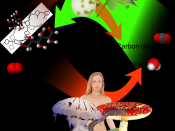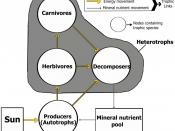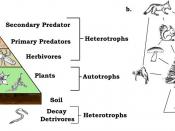Ecosystems are comprised of various trophic levels, or groups of plants and animals that reflect their main energy source. Ecological pyramids can be used to show the relationship between trophic levels. An ecosystem includes autotrophs and heterotrophs. Organisms from each trophic level, feeding on one another, make up a series called a food chain. In real life, it is rather rare for a given organism to feed only on one other type of organism. Therefore, when diagramming the relationships, biologist use a food web, which shows the relationship using branched lines oppose to straight lines. This is because an organism may feed on two or more kinds and in turn is eaten by several other kinds of organisms. The complexity of the food web is an example of a complex system.
Within a food web, there are producers, consumers, and decomposers. Producers, also called autotrophs, make their own food and can support themselves.
Once energy enters an ecosystem, usually from photosynthesis, it is slowly released as metabolic processes proceed. Green plants, the primary producers of a land ecosystem, capture light energy and convert it into food energy. This group consists of autotrophs that convert solar energy into chemical energy; they do not need to obtain their energy from other living organisms. Thus, the sun is the source of all energy, because it provides the plants with the energy to undergo photosynthesis and produce food. When these plants are consumed by other organism, this continues the food chain. Consumers also know as heterotrophs, are organisms that feed on other organisms. A primary consumer, or herbivores, feed directly on the green plants. While secondary consumers, carnivores and the parasites of animals, feed in turn on the herbivores. The autotrophs that first acquire this energy provide all of the...


